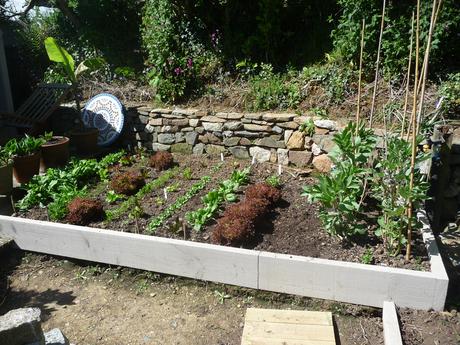We are now self sufficient in salad leaves - hopefully for the rest of the summer! Rocket, Coriander,  Mustard and Radish have all done well in the garden and the leaves are unmarked by pesky Flea Beetle which was always a problem on the allotment. This did not affect the eating quality but the leaves always looked moth eaten. I like to sow a few loose leaved lettuce every couple of weeks and this keeps the supply coming. Sown into small pots or bedding plant trays, the young plants are ideal to pop into any gaps that appear. Short rows of radish and other leaves are also sown on a regular basis.
Mustard and Radish have all done well in the garden and the leaves are unmarked by pesky Flea Beetle which was always a problem on the allotment. This did not affect the eating quality but the leaves always looked moth eaten. I like to sow a few loose leaved lettuce every couple of weeks and this keeps the supply coming. Sown into small pots or bedding plant trays, the young plants are ideal to pop into any gaps that appear. Short rows of radish and other leaves are also sown on a regular basis.
I have managed to squeeze a few Broad Bean plants into the raised bed and these have grown well and are full of their beautiful black and white blooms. There are plenty of bees pollinating the flowers so beans will follow! This autumn I really must sow a row of broad beans so that we are eating them now – they are one of my favorite vegetables.
My other raised bed, lent to me by a friend, has carrots, onions and beetroot all growing well but not yet ready to harvest. I have sown a row of Parsnips which are just germinating and have planted out my courgettes on mounds of rotted manure. The peas have been a disaster and are being eaten by Sparrows! We have tried surrounding them with horticultural fleece and I have staked the rows to deter them but they are only just starting to grow away. Some are badly damaged so I will make one row out of two and this will give me room to plant my dwarf French beans which have just come up in the greenhouse.
Runner beans are easy to grow but preparing the site is time consuming if you are to get good results. I like to open a trench of soil and dig the base thoroughly before adding a thick layer of well rotted manure and replacing the soil. I have never sown bean seeds directly into the ground, preferring to bring the plants on so that they are strong enough to withstand slug and snail attacks. Once the trench is filled, I put up the row of bamboo canes crossing them over half way up so that the beans hang down and are easy to see for picking. A bamboo cane is then tied across the frame, nestling into the cross pieces. Hopefully this structure is strong enough to take the weight of the crop and withstand any late summer gales which have undone many crops, bruising the leaves and knocking off the flowers!
Dwarf French beans follow the same procedure as far as soil preparation goes but do not need a climbing frame. I do like to put small bamboo cane in at intervals around the row and tie string around them to support the plants which can suffer from ‘wind rock’. Planting a double row, staggering the plants also helps them to support each other.
For now we are enjoying the first of the salads and looking forward to finger carrots, spring onions and beetroot along with the broad beans and courgettes in a few weeks time. Had the peas not been under attack from the Sparrows, they would have been flowering by now and well on the way to producing their tasty crop which so often are eaten raw in the garden before they can make it to the kitchen!
